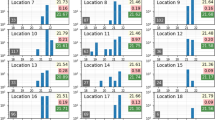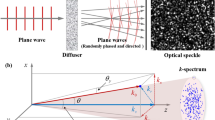Abstract
A DETERMINATION of the Doppler width of the λ 5577 oxygen line in the night sky spectrum was attempted by Babcock1; but his instrumentation permitted only an estimate of the upper limit of this width and hence of the temperature of the emitting layer. We wish to report here preliminary results of a new study of the λ 5577 line using improved interferometric apparatus.
This is a preview of subscription content, access via your institution
Access options
Subscribe to this journal
Receive 51 print issues and online access
$199.00 per year
only $3.90 per issue
Buy this article
- Purchase on SpringerLink
- Instant access to full article PDF
Prices may be subject to local taxes which are calculated during checkout
Similar content being viewed by others
References
Babcock, H. D., Astrophys. J., 57, 209 (1923).
Chabbal, R., J. Recherches du Centre Nat. Recherches Sci., No. 24, 138 (1953).
van de Hulst, H. C., and Reesinck, J. J. M., Astrophys. J., 106, 121 (1947).
Roach, F. E., and Pettit, H. B., J. Geophys. Research, 56, 325 (1951).
Author information
Authors and Affiliations
Rights and permissions
About this article
Cite this article
WARK, D., STONE, J. Measurement of the Doppler Width of the λ 5577 Line in the Night Sky. Nature 175, 254–255 (1955). https://doi.org/10.1038/175254b0
Issue date:
DOI: https://doi.org/10.1038/175254b0
This article is cited by
-
Fabry-Perot spectroscopy in space science
Journal of Earth System Science (1984)
-
Airglow
Space Science Reviews (1965)
-
La dissociation de l'oxygène dans la haute atmosphère
Archiv für Meteorologie, Geophysik und Bioklimatologie Serie A (1958)
-
A Determination of the Line-width of the λ6300 Line of Oxygen in the Twilight Sky
Nature (1956)



